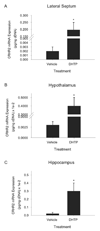Androgen regulation of corticotropin-releasing hormone receptor 2 (CRHR2) mRNA expression and receptor binding in the rat brain
- PMID: 18706413
- PMCID: PMC2891365
- DOI: 10.1016/j.expneurol.2008.07.013
Androgen regulation of corticotropin-releasing hormone receptor 2 (CRHR2) mRNA expression and receptor binding in the rat brain
Abstract
Stress-induced affective disorders, such as depression and anxiety, are more prevalent in females than in males. The reduced vulnerability to these disorders in males may be due to the presence of androgens, which are known to dampen the stress response and reduce anxiety-like behaviors. However, a neurobiological mechanism for this sex difference has yet to be elucidated. Corticotropin-releasing hormone receptor 2 (CRHR2) has been implicated in regulating anxiety-type behaviors and is expressed in stress-responsive brain regions that also contain androgen receptors (AR). We hypothesized that androgen may exert its effects through actions on CRHR2 and we therefore examined the regulation of CRHR2 mRNA and receptor binding in the male rat forebrain following androgen administration. Young adult male Sprague/Dawley rats were gonadectomized (GDX) and treated with the non-aromatizable androgen, dihydrotestosterone propionate (DHTP) using hormone filled Silastic capsules. Control animals received empty capsules. Using quantitative real-time RT-PCR, CRHR2 mRNA levels were determined in block-dissected brain regions. DHTP treatment significantly increased CRHR2 mRNA expression in the hippocampus, hypothalamus, and lateral septum (p<0.01) when compared to vehicle-treated controls. A similar trend was observed in amygdala (p= 0.05). Furthermore, in vitro autoradiography revealed significantly higher CRHR2 binding in the lateral septum in androgen-treated males, with the highest difference observed in the ventral lateral region. Regulation of CRHR2 mRNA by AR was also examined using an in vitro approach. Hippocampal neurons, which contain high levels of AR, were harvested from E17-18 rat fetuses, and maintained in primary culture for 14 days. Neurons were then treated with dihydrotestosterone (DHT; 1 nM), DHT plus flutamide (an androgen receptor antagonist), or vehicle for 48 h. CRHR2 mRNA levels were measured using quantitative real-time RT-PCR. Consistent with in vivo studies, DHT significantly increased CRHR2 mRNA expression in hippocampal neurons (p<.02) compared to vehicle-treated controls. Flutamide treatment prevented the effect of DHT on CRHR2 mRNA indicating that DHT's effect on CRHR2 expression is AR-mediated. Thus, the CRHR2 gene appears to be a target for regulation by AR and these data suggest a potential mechanism by which androgen may alter mood and anxiety-related behaviors.
Figures



Similar articles
-
Intrahippocampal administration of an androgen receptor antagonist, flutamide, can increase anxiety-like behavior in intact and DHT-replaced male rats.Horm Behav. 2006 Aug;50(2):216-22. doi: 10.1016/j.yhbeh.2006.03.003. Epub 2006 Apr 24. Horm Behav. 2006. PMID: 16631174
-
Estrogen, but not androgens, regulates androgen receptor messenger ribonucleic acid expression in the developing male rat forebrain.Endocrinology. 1999 Aug;140(8):3674-81. doi: 10.1210/endo.140.8.6901. Endocrinology. 1999. PMID: 10433226
-
Androgens modulate glucocorticoid receptor mRNA, but not mineralocorticoid receptor mRNA levels, in the rat hippocampus.J Neuroendocrinol. 1996 Jun;8(6):439-47. doi: 10.1046/j.1365-2826.1996.04735.x. J Neuroendocrinol. 1996. PMID: 8809674
-
Androgen Regulation of Corticotropin Releasing Factor Receptor 1 in the Mouse Brain.Neuroscience. 2022 May 21;491:185-199. doi: 10.1016/j.neuroscience.2022.04.005. Epub 2022 Apr 7. Neuroscience. 2022. PMID: 35398506 Free PMC article.
-
Mechanism of action and pure antiandrogenic properties of flutamide.Cancer. 1993 Dec 15;72(12 Suppl):3816-27. doi: 10.1002/1097-0142(19931215)72:12+<3816::aid-cncr2820721711>3.0.co;2-3. Cancer. 1993. PMID: 8252497 Review.
Cited by
-
Androgen regulation of behavioral stress responses and the hypothalamic-pituitary-adrenal axis.Horm Behav. 2024 Jun;162:105528. doi: 10.1016/j.yhbeh.2024.105528. Epub 2024 Mar 18. Horm Behav. 2024. PMID: 38503191 Free PMC article. Review.
-
Exposure to di-(2-ethylhexyl) phthalate transgenerationally alters anxiety-like behavior and amygdala gene expression in adult male and female mice.Physiol Behav. 2019 Aug 1;207:7-14. doi: 10.1016/j.physbeh.2019.04.018. Epub 2019 Apr 22. Physiol Behav. 2019. PMID: 31022410 Free PMC article.
-
Corticotropin-Releasing Factor Family: A Stress Hormone-Receptor System's Emerging Role in Mediating Sex-Specific Signaling.Cells. 2020 Mar 31;9(4):839. doi: 10.3390/cells9040839. Cells. 2020. PMID: 32244319 Free PMC article. Review.
-
Negative consequences of early-life adversity on substance use as mediated by corticotropin-releasing factor modulation of serotonin activity.Neurobiol Stress. 2018 Aug 7;9:29-39. doi: 10.1016/j.ynstr.2018.08.001. eCollection 2018 Nov. Neurobiol Stress. 2018. PMID: 30151419 Free PMC article. Review.
-
Androgens and Their Role in Regulating Sex Differences in the Hypothalamic/Pituitary/Adrenal Axis Stress Response and Stress-Related Behaviors.Androg Clin Res Ther. 2021 Dec 23;2(1):261-274. doi: 10.1089/andro.2021.0021. eCollection 2021. Androg Clin Res Ther. 2021. PMID: 35024695 Free PMC article. Review.
References
-
- Adler A, Vescovo P, Robinson JK, Kritzer MF. Gonadectomy in adult life increases tyrosine hydroxylase immunoreactivity in the prefrontal cortex and decreases open field activity in male rats. Neuroscience. 1999;89:939–954. - PubMed
-
- Amore M. Partial androgen deficiency and neuropsychiatric symptoms in aging men. J Endocrinol Invest. 2005;28:49–54. - PubMed
-
- Angold A, Worthman CW. Puberty onset of gender differences in rates of depression: a developmental, epidemiologic and neuroendocrine perspective. J Affect Disord. 1993;29:145–158. - PubMed
-
- Arborelius L, Owens MJ, Plotsky PM, Nemeroff CB. The role of corticotropin-releasing factor in depression and anxiety disorders. J Endocrinol. 1999;160:1–12. - PubMed
Publication types
MeSH terms
Substances
Grants and funding
LinkOut - more resources
Full Text Sources
Research Materials

